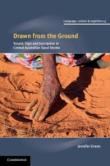 2318515543243328018.jpg
2318515543243328018.jpg
 Drawn From The Ground : Sound, Sign and Inscription in Central Australian Sand Stories
single work
Drawn From The Ground : Sound, Sign and Inscription in Central Australian Sand Stories
single work
 2318515543243328018.jpg
2318515543243328018.jpg
 Drawn From The Ground : Sound, Sign and Inscription in Central Australian Sand Stories
single work
Drawn From The Ground : Sound, Sign and Inscription in Central Australian Sand Stories
single work
'Sand stories from Central Australia are a traditional form of Aboriginal women's verbal art that incorporates speech, song, sign, gesture and drawing. Small leaves and other objects may be used to represent story characters. This detailed study of Arandic sand stories takes a multimodal approach to the analysis of the stories and shows how the expressive elements used in the stories are orchestrated together. This richly illustrated volume is essential reading for anyone interested in language and communication. It adds to the growing recognition that language encompasses much more than speech alone, and shows how important it is to consider the different semiotic resources a culture brings to its communicative tasks as an integrated whole rather than in isolation.' (Source: Publishers website)
This work contains:
1. Introduction
2. Sand stories as social and cultural practice
3. Catching a move as it flies: multimodal data collection
4. Lines in the sand
5. Body-anchored and airborne action
6. Ordering, re-drawing and erasure
7. Vocal style in sand stories
8. Crossing boundaries
'Green's book provides a fascinating and fine-grained analysis of a traditional narrative practice among Arrernte women that entails the telling of ‘sand stories’. Green's principle concern is how the technique of sand drawing is used in conjunction with speech, gesture, hand signs and song to communicate meaning. The complexity of sand story narration is such that it is difficult to separate these different semiotic modalities from each other. Indeed, ‘in isolation, each of these modalities does not carry the entire message’ (2014: 90). Accordingly, Green focuses on sand drawing as part of an ‘ensemble’ of expressive forms. Her approach is informed by new developments in linguistics and anthropology which view language as more than just speech and emphasise its embodied nature.' (Introduction)
'Green's book provides a fascinating and fine-grained analysis of a traditional narrative practice among Arrernte women that entails the telling of ‘sand stories’. Green's principle concern is how the technique of sand drawing is used in conjunction with speech, gesture, hand signs and song to communicate meaning. The complexity of sand story narration is such that it is difficult to separate these different semiotic modalities from each other. Indeed, ‘in isolation, each of these modalities does not carry the entire message’ (2014: 90). Accordingly, Green focuses on sand drawing as part of an ‘ensemble’ of expressive forms. Her approach is informed by new developments in linguistics and anthropology which view language as more than just speech and emphasise its embodied nature.' (Introduction)